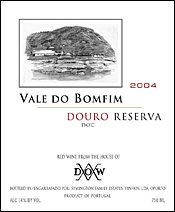I can still remember the trip I made to the Douro in 2000 to explore the emerging table wine production there. I tasted some fantastic red wines (and some just-average wines) made from the classic varieties used for Port, from vineyards whose grapes were formerly dedicated to Port production. Those wines really moved me. I felt a bit like Columbus, discovering a whole new world that actually had been there all along.
This wine from Dow was not one of those that I tasted on that trip, because this 2004 is the first vintage of Vale do Bomfim. Initially, it was the Douro's smaller wineries that drove the table wine production, and most of them were Portuguese houses, such as Ferreira and Ramos Pinto, as opposed to what have come to be known as the "English" houses (such as Dow, Graham, and Warre--all owned by the Symington Family--as well as Taylor Fladgate, Croft and Sandeman's). Those English houses, for the most part, represent the upper crust of Port production.
At the time, I theorized that those companies were, logically, reluctant to enter the Douro table wine business because they controlled so much of Port production that they preferred to see good grapes go into Port than table wine. Time has proven me wrong, as the Symingtons have now released five Douro DOC reds--two of them from Quinta de Roriz, jointly owned by the Symington and van Zeller families (formerly owners of Quinta do Noval Porto), and two of them produced in partnership with Bruno Prats of Bordeaux. Vale do Bomfim is the fifth and most recent.
The riches of the Douro Valley for producing great table wine apparently could not be denied. Those riches include a warm, dry, climate (except in the Baixo Corgo, the most westerly Douro district, which is wetter and cooler than the districts upriver), poor soils, and several outstanding, if relatively unknown, grape varieties.
 The 2004 Vale do Bomfim has equal parts of Touriga Franca and Tinta Roriz (Tempranillo), with 20 percent Tinta Barocca. (Missing is the great Touriga Nacional, reputedly the best grape in the Douro, but perhaps too powerful for this blend.) The combination creates a wine that's full-bodied with ripe, plump fruit flavors, especially plum, with accents of black pepper, tea and tobacco.
The 2004 Vale do Bomfim has equal parts of Touriga Franca and Tinta Roriz (Tempranillo), with 20 percent Tinta Barocca. (Missing is the great Touriga Nacional, reputedly the best grape in the Douro, but perhaps too powerful for this blend.) The combination creates a wine that's full-bodied with ripe, plump fruit flavors, especially plum, with accents of black pepper, tea and tobacco.
This wine has serious tannin--more from the grapes than from oak, it seems--that is well integrated, running all through the wine almost from the attack, and the texture overall is rich rather than tough. The wine is completely dry, without that suggestion of ripe-fruit sweetness that is typical in New World wines. It's a gritty, gutsy, dense red. But it's so well-balanced that I hardly noticed its 14 percent alcohol.
I would have liked this wine if it cost $25 or even a bit more, and was delighted to see that it cost just a bit more than half of that. And that's another advantage of Douro reds: their prices are so reasonable because they are relatively unknown wines, as all Portuguese reds are. The low prices for these wines have nothing to do with their quality, and are only an indicator of their lack of market recognition.
Serve this wine with stews, meat dishes that have herbal notes, rare steaks, or an Italian chick pea soup with rosemary. It's also great with grilled chicken or veal. The wine can handle a large glass, although it tastes fruitier in a medium-sized glass. As for its aging potential, I wouldn't be concerned about laying it away for five years--and maybe it will age longer. Who knows?
89 Points